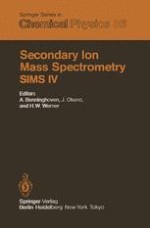1984 | OriginalPaper | Chapter
The Application of SIMS and Other Surface Techniques to the Study of Antimony-Doped Tin Oxide Surfaces
Authors : G. B. Hoflund, P. H. Holloway, W. H. Hocking
Published in: Secondary Ion Mass Spectrometry SIMS IV
Publisher: Springer Berlin Heidelberg
Included in: Professional Book Archive
Activate our intelligent search to find suitable subject content or patents.
Select sections of text to find matching patents with Artificial Intelligence. powered by
Select sections of text to find additional relevant content using AI-assisted search. powered by
Surface studies of real catalyst surfaces are exceedingly difficult because the surfaces usually contain many elements, small concentrations of certain species may determine the catalytic behavior of the surface, the spatial distribution of the species is highly inhomogeneous and the active surfaces are often smaller than the probe dimensions and may not be directly accessible for surface studies. Nevertheless, much progress is being made in characterizing model catalysts using ultrahigh vacuum surface techniques such as electron spectroscopy for chemical analysis (ESCA), ultraviolet photoemission spectroscopy (UPS), Auger electron spectroscopy (AES), electron stimulated desorption (ESD), secondary ion mass spectrometry (SIMS) and many others. The model catalytic surface usually is prepared on a planar substrate which is convenient for surface analysis.
